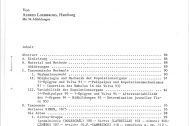Rok
1983Obsah
The structure of the copulatory Organs of Heriaeus SIMON is analysed and the functional variability of these Organs Is suggested. On the basis of this analysis the Old World crab-spider genus Heriaeus SIMON, 1875, is reviewed. The type-species of Heriaeus was misidentified by SIMON. The designation of Thomisus hirtus LATREILLE, 1819, as type-species can promote the stability of the generic name Heriaeus SIMON, 1875.
15 species of Heriaeus are described or redescribed and illustrated (including 6 new species) . 5 remaining species are designated according to the descriptions of the original authors. H. difficilis STRAND, 1906, and H. melanotrichus SIMON, 1903, are nomina dubia.
The genus comprises at least 3 phyletic lines. (1) The hirtus-group contains 10 palearcticspecies. H. graminicola (DOLESCHAL,1852), is revalidized. H. oblongus SIMON, 1918, is a synonym of H. mellottei SIMON, 1886. H. propinquus KULCZYtlSKI, 1903, is synonymized under H. simonii KULCZYf^SKI, 1903. (2) The huffonii-group contains 3 species from the palearctic region. (3) The transvaalicus-group is represented by one species of South Africa.
The distribution of the species of the hirtus-group is summarized in two maps. The possible effect of climatic changes during the pleistocene on the distribution patterns is discussed. Finally, the conclusions on isolating mechanisms between the taxonomic species are explained. The 5 related, west-palearctic species graminicola, hirtus, simonii, setiger and numidicus (hirtus-complex) show allopatric distribution. As their copulatory organs are morphologically compatible, the discrimination of these taxa as real biospecies requires further investigations. Parapatry, especially between the mediterranean species hirtus and simonii, should be examined.
15 species of Heriaeus are described or redescribed and illustrated (including 6 new species) . 5 remaining species are designated according to the descriptions of the original authors. H. difficilis STRAND, 1906, and H. melanotrichus SIMON, 1903, are nomina dubia.
The genus comprises at least 3 phyletic lines. (1) The hirtus-group contains 10 palearcticspecies. H. graminicola (DOLESCHAL,1852), is revalidized. H. oblongus SIMON, 1918, is a synonym of H. mellottei SIMON, 1886. H. propinquus KULCZYtlSKI, 1903, is synonymized under H. simonii KULCZYf^SKI, 1903. (2) The huffonii-group contains 3 species from the palearctic region. (3) The transvaalicus-group is represented by one species of South Africa.
The distribution of the species of the hirtus-group is summarized in two maps. The possible effect of climatic changes during the pleistocene on the distribution patterns is discussed. Finally, the conclusions on isolating mechanisms between the taxonomic species are explained. The 5 related, west-palearctic species graminicola, hirtus, simonii, setiger and numidicus (hirtus-complex) show allopatric distribution. As their copulatory organs are morphologically compatible, the discrimination of these taxa as real biospecies requires further investigations. Parapatry, especially between the mediterranean species hirtus and simonii, should be examined.



